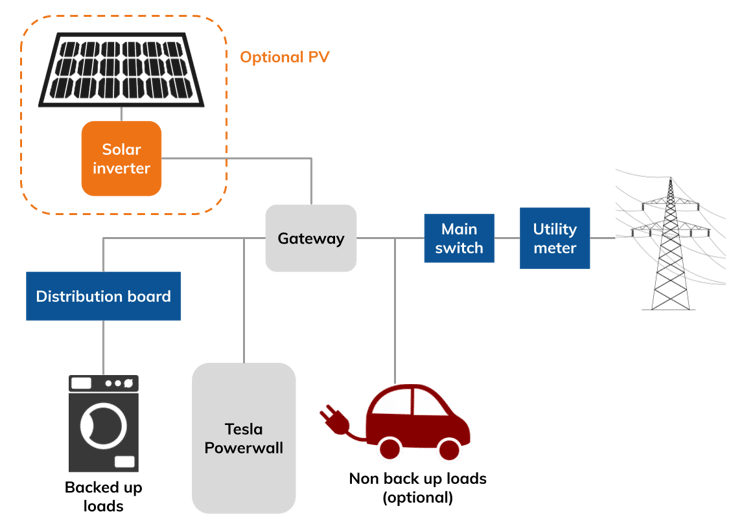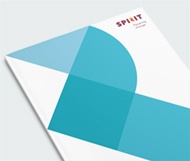
| Usable capacity: | 13.5kWh |
| Power output: | 3.68kW or 5kW (subject to grid permission) |
| Round-trip efficiency: | > 90% |
| Monitoring: | Tesla app |
| Warranty: | 10 years |
| Mounting: | Wall- or floor-mounted and can be stacked |
| Location: | Indoor or outdoor installation |
| Dimensions (main unit): | H 1,150mm x W 753mm x D 147mm |
| Weight: | 114kg |
| Energy density (including inverter / charger): | 100 kWh / m3 |

The system offers a range of functionality:
Note if you have previously installed a Powerwall 2 unit without backup (likely pre-2019), you would need to upgrade the Gateway to enable backup functionality - see installation section below.
Tesla Powerwall 2 consists of the main unit (see picture in our downloadable guide) which houses the battery and inverter/charger, as well as a smaller Energy Gateway which measures the energy flows through the house and directs the battery to charge or discharge accordingly. It also 'islands' the house in a power cut, enabling the solar system to keep working and the battery to charge and discharge.
The gateway is a stylish frosted glass-fronted ‘mini’ version of Tesla Powerwall 2, measuring 380mm wide x 584mm tall x 127mm deep, and weighing 9.8kg. It is IP55 rated, so suitable for outdoors, and can be padlocked to stop any unwanted access.
The gateway is installed near the electricity meter. The main battery unit should be relatively close to the gateway, otherwise the installation cost increases. The ideal scenario is an integrated garage with the meter and fuseboard inside. If there is no garage, the main unit usually goes on the outside wall as close as possible to the gateway and electricity meter. The installation typically takes up to a day for two installers.
A typical schematic is as follows:

Another advantage of the Tesla Powerwall 2 when it comes to installation is its in built capability for export limitation. It is capable of a maximum output of 5kW, but can be easily set to a maximum output of 3.68kW. This removes the need for DNO approval if you are installing a battery in isolation and is a feature few other batteries have. However, this will reduce the rate of charge and discharge of the battery, as well as reduce the capability of the battery to power your home during a power cut, as it won't be able to power as many loads. One way round this is to install the battery limited to 3.68kW while applying for the DNO which can take up to 11 weeks, and simply change the setting to 5kW upon DNO approval.
The Powerwall battery cells are made from lithium manganese cobalt (LMNC). In this respect, it differs from many of the other home storage technologies on the market (and all of the other batteries which we offer), all of which use lithium ferro phosphate (LFP). In our view, lithium ferro phosphate offers a superior chemistry to lithium manganese cobalt.
LFP offers many more lifecycles (one lifecycle being a round-trip in and out of a kWh) – i.e. many more storage slots. Typically 8,000 – 10,000 lifecycles for lithium ferro phosphate, compared to 4,500 for lithium manganese cobalt. This means that each 'storage slot' costs a lot less for LFP than it does for LMNC.
It is surprising that Tesla has gone against the market norm in their choice of chemistry.
Across the nation, electricity demand reaches a high in the late weekday afternoons (4-7pm), and then falls to a low overnight. However, to date most domestic properties have paid a single rate electricity tariff which doesn’t reflect the peaks and troughs of demand. Some domestic properties are on an Economy 7 (or Economy 10) tariff with a peak rate and an off-peak rate.
More suppliers are starting to trial or offer time-of-use (ToU) tariffs, with time banded tariffs reflecting demand and supply across the nation and the true underlying cost of electricity.
With the advent of smart meters, able to record half hourly electricity use, the market will gradually witness the introduction of many more such time-of-use tariffs. Clearly there are large savings to be made by buying electricity at night and using it in the day. Time-based controls are now in place for Powerwall 2.
The system user can choose between two different control modes in the Tesla app:
| Mode | Backup reserve | Solar self usage % | Savings | Who should do this? |
| Self-powered | Configurable (0-100%) | Great! | OK | "I want to minimise my carbon footprint" |
| Time-based control | Configurable (0-100%) | OK | Great! | "I have a ToU tariff and want to maximise my savings" |
You don’t even need a solar system to benefit from time-of-use charge and discharge. That said, the best savings will be realised through a combination of solar self-consumption and ToU charging and discharging.
Tesla Powerwall 2 enables you to continue providing power to your home or business during power cuts. It also allows your solar PV system to keep running in a power cut (as long as the system is subject to size limits below).
Tesla Powerwall can be installed to back up the whole house, or it can be installed such that it backs up only certain loads. Even with ‘whole house’ backup, certain large loads (such as a car charger) can technically be excluded via load shedding, though our preference is to differentiate backed up and non-backed up loads when wiring up.
The system will switch automatically although the switch will not be to UPS (uninterrupted power supply) standard. Tesla claims that in general you won’t notice the switch (except via a notification on the Tesla app), but don’t rely on the seamlessness of the system if you have critical loads requiring seamless backup e.g. life support equipment.
You will need to specify a reserve percentage (e.g. 30%) and the system will always keep that percentage of the capacity in reserve for a power cut. This setting can be changed.
If the grid goes down and the loads in the house exceed 5kW, (or if they exceed 3.68kW for a system set on the lower 3.68kW power output at commissioning), the battery will shut down. The system will spend the next hour sending you reminders to turn off high power loads so that the total load falls below 5kW and the battery can restart. After this the battery will need a manual reset to reboot (via the gateway box).

Not only will a backup enabled system keep the lights on in a power cut, it will also keep the solar system functioning. The system will continue to function whilst there is either a load or sufficient spare battery capacity to soak up the solar electricity it produces.
If there is insufficient load or battery capacity to soak up the solar, the system will automatically power down the solar. However it should be noted that for this to work effectively don’t connect more than 7.6kWp of solar to a system with a single Powerwall set at 5kW output. If Powerwall is set at 3.68kW (due to DNO constraints), don’t connect more than 5kWp.
If you want more solar, you need more Tesla Powerwalls, or you need to connect the solar 'upstream' of the gateway so that the solar disconnects in a power cut…
The sizing of the Tesla Powerwall 2 means that with full backup power (5kW), with some judicious juggling, your life should continue undisturbed through the average power cut. That said, you should probably wait until the power comes on before using an electric dryer, and if you want to ensure you can continue to cook up a storm in the kitchen, it’s probably best to install two Powerwalls.
If you reserve 30% of your battery (4kWh), then you should be able to watch TV, use your laptop and keep the lights and freezer working for almost four hours, whilst enjoying a few cups of coffee in the process.
Typical loads are as follows:
Kitchen
Office and entertainment
Lighting
Laundry / dishwasher
Note that if you try and run more than the 5kW load limit, Tesla Powerwall 2 will stretch to 7kW for a few seconds, but after that you will see some brownout behaviour, as indeed you would if you tried to import more than your 100A supply from the grid.

Most households run on a single phase connection (230V). If you have a 3-phase connection (400V), Tesla Powerwall 2 can still be used but with the following limitations:
Pros
Powerwall 2 is AC-coupled and therefore compatible with any solar system when connected to the grid. It can be configured to allow any single phase solar system up to 7.6 kW AC rating to continue to function in a power cut (subject to install restrictions).
Tesla Powerwall costs around £7500 excl VAT, with prices varying depending on installation requirements. It used to be that if installed as part of a domestic solar system (or an 'extension system') the applicable VAT rate will be 0%. Otherwise the VAT rate will be 20%. But as of Feb 1st 2024, the VAT rate for battery only installations or battery retrofits was reduced to 0% in line with Solar PV installations.
Spirit is a Tesla Powerwall certified installer.
| Is Tesla Powerwall 2 right for me? |  |
 |
Or if you are having your Powerwall installed, check out our Tesla FAQs.
Interested about finding out about other battery systems?
Copyright © Spirit Energy 2025 · info@spiritenergy.co.uk · 0118 951 4490
Jobs and Careers
Interested in joining the Spirit team? Email jobs@spiritenergy.co.uk
Spirit House, 25 Albury Close, Reading, RG30 1BD
(Location formerly known as 44 Portman Road, Reading, RG30 1EA)
Spirit Energy is the trading name of Spirit Solar Ltd · UK Company Number 07138647
Although care is taken to ensure that the information on our website (www.spiritenergy.co.uk) and any guides, calculators or checklists provided by us, electronically or otherwise, are accurate and up-to-date, we cannot accept any responsibility for mistakes or omissions. We enter into no express or implied conditions, warranties, terms or representations regarding the quality, accuracy or completeness of the information. We exclude to the extent lawfully permitted all liability for loss or damage, whether direct, indirect or consequential arising out of your use of our website or any guides, calculators or checklists provided by us, or from any information or omission contained in our website or any guides, calculators or checklists provided by us.